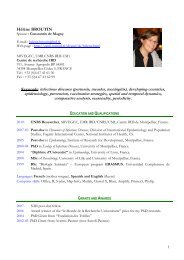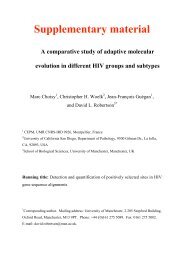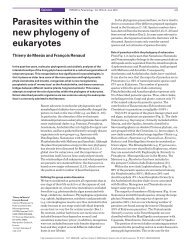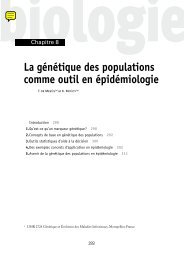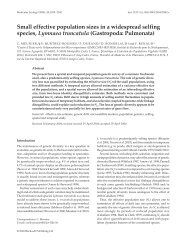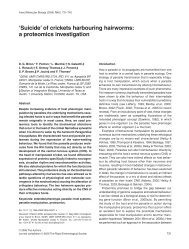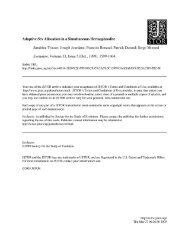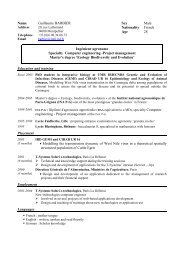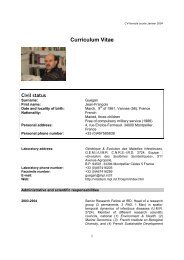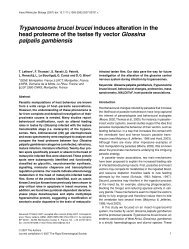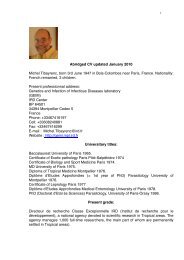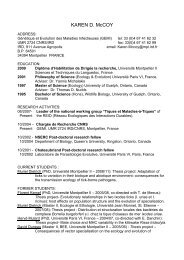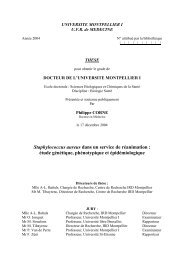écologie des virus influenza aviaires en Camargue - IRD
écologie des virus influenza aviaires en Camargue - IRD
écologie des virus influenza aviaires en Camargue - IRD
Create successful ePaper yourself
Turn your PDF publications into a flip-book with our unique Google optimized e-Paper software.
« The ecological significance of manipulative parasites »Ecology of parasitically modified populationsWh<strong>en</strong> the shift in ph<strong>en</strong>otype caused by parasites is large, and wh<strong>en</strong> preval<strong>en</strong>ce in thehost population is less than 100%, the distribution of trait values is likely to become bimodal,with parasitized and unparasitized individuals forming distinct groups [11,13]. For instance,the ecology of Gammarus ins<strong>en</strong>sibilis (Figure 1.a) populations could not be fully understoodwithout acknowledging the fact that a fraction of the population harbours the manipulativeparasite Microphallus papillorobustus [14]. Not only does this parasite split its hostpopulation into two discrete subunits (one at the water surface and one near the bottom), butseveral differ<strong>en</strong>ces also exist betwe<strong>en</strong> the characteristics of individuals from the two subunits(differ<strong>en</strong>ces in body size, intermoult duration, fecundity, physiology, d<strong>en</strong>sity of individuals,etc). The pattern of mating is also deeply influ<strong>en</strong>ced, with paired individuals being matchedfor the pres<strong>en</strong>ce or abs<strong>en</strong>ce of the parasite.Infection by the trematode Cercaria batillariae causes a large portion of the Asianmud snail (Batillaria cumingi) population to move lower in the intertidal zone [15]. Infectedsnails thereby increase their submerg<strong>en</strong>ce time, which increases access of cercariae to theirsecondary host, a fish. This parasite also induces gigantism in the mollusc. These shifts inhabitat and size change resource utilization within the snail population. The movem<strong>en</strong>t ofinfected snails away from uninfected snails alleviates competition with the remainingreproductive snails. Interestingly in this case, we can no longer speak of intraspecificcompetition since infected snails are castrated and produce only larval tremato<strong>des</strong>, so that itbecomes more a case of interspecific competition betwe<strong>en</strong> uninfected snails and tremato<strong>des</strong>with a similar (snail) ph<strong>en</strong>otype [15].Thus, just because of a manipulative parasite, a giv<strong>en</strong> host population in a giv<strong>en</strong>ecosystem consists of at least two groups with differ<strong>en</strong>t ecological traits. Ev<strong>en</strong> thoughexamples <strong>des</strong>cribed above [14,15] focussed on spatial segregation betwe<strong>en</strong> infected anduninfected individuals, sources of ph<strong>en</strong>otypic heterog<strong>en</strong>eity betwe<strong>en</strong> infected and uninfectedsubunits are pot<strong>en</strong>tially numerous (e.g. body size, physiology, life history traits). Theseeffects not only influ<strong>en</strong>ce host population biology, they also affect biotic interactions andthus result in profound ecological consequ<strong>en</strong>ces.195



